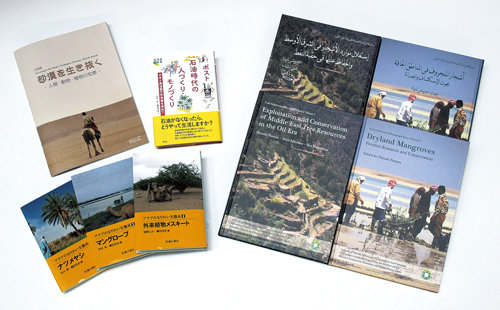A Study of Human Subsistence Ecosystems in Arab Societies:
To Combat Livelihood Degradation for the Post-oil Era
- R-05
- CR①
- CR②
2015

Project Publications
Research objectives and background
Japan and the oil-rich countries of the Middle East have put excessive pressures on the Earth’s energy, water, and food resources. In prioritizing their own economic prosperity, these countries have exploited irreplaceable resources, such as fossil fuel and fossil water. Schemes to plant alien species have also placed stress on local ecosystems. Such practices have increased social and economic differences among the peoples of the Middle East at a time when the region faces a turning point in modern oil-based industrialization. The current fossil fuel–based interdependencies must be transformed into new relations that can support viable future societies.
Our project was focused on human subsistence ecosystems, namely life-support mechanisms and self-sufficient modes of production (hunting, gathering, fishing, herding, farming, and forestry) with low energy resource consumption. Based on our results, we proposed a scientific framework for strengthening subsistence productivity and rehabilitating daily life in Arab societies in the post-oil era.
Study outcomes
- 1) Publication of ten volumes of Arab Subsistence Ecosystems in Japanese
- 2) The Surviving in the Desert exhibit at the National Museum of Nature and Science
- 3) Feedback from Japanese citizens regarding the post-oil era
- 4) Publication of the Arab Subsistence Monograph series in multiple languages
- 5) Research implementation through development projects in Arab societies
Camels, date palms, dugongs, mangroves, and coral (reefs) are believed to be the keystone species of Arab human subsistence ecosystems (social ecosystems). These species support diverse communities and their extinction could lead to the disappearance of other species and human communities. The survival of these species is likely to depend on the wise use of ecotones, socio-ecological niches in the arid Middle East environment (Nawata 2010). The ten volumes of Arab Subsistence Ecosystems were published to describe our results on the following: 1) interrelationships between humanity and nature; 2) date palms, 3) mangroves, 4) the alien species mesquite, 5) camels, 6) coral reefs, 7) dugongs, 8) sorghum and millet, 9) motivated practitioners and local communities, and 10) is the modern human really a keystone species?
The exhibition Surviving in the Desert: Strategies of Humans, Plants, & Animals ran at the National Museum of Nature and Science, Tokyo, from November 2013 to February 2014. Research results and materials collected in this project were on display. The exhibition organized twenty-seven gallery talks, symposia and lectures to communicate with Japanese citizens. More than one hundred thousand visitors visited the exhibit, demonstrating a significant public interest in the project’s findings on contemporary environmental problems.
A RIHN book series volume titled Human Resources and Engineering in the Post-Oil Era: A Search for Viable Future Societies in Japan and Oil-Rich Countries of the Middle East was edited by the Project Leader and Project Researcher, based on feedback from Japanese citizens on the post-oil era, after attending three RIHN Open Seminars for the public on “How will you live without oil?” presented between 2009 and 2011 (Ishiyama & Nawata eds. 2013). One book review said: “This book took the initiative in examining renewable human resources and engineering to get ready for the post-oil era” (June 5, 2013, Environment Newspaper).
In order to increase the availability of scientific knowledge and provide universal and equitable access to scientific data and documents, we made our results accessible to local and national decision-makers by reporting the results in English, the common language of the scientific community, and in Arabic, French, English, and Kiswahili, the languages of the communities in the study region, in the first volume Exploitation and Conservation of Middle East Tree Resources in the Oil Era (Nawata, Ishiyama & Nakamura, 2013).
The results of the study were applied as part of the Japan International Cooperation Agency project “Capacity Development Project for the Provision of Services of Basic Human Needs in Kassala” (2011–2013) in cooperation with the Sudan University of Science and Technology. Based on joint Japanese and Sudanese research, we organized a training course on mesquite management and utilization for outreach workers. The results were immediately presented at an international conference and published in an academic book (Mendez-Vilas ed. 2012).
